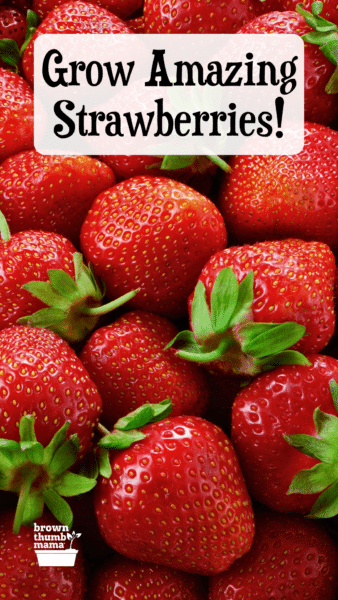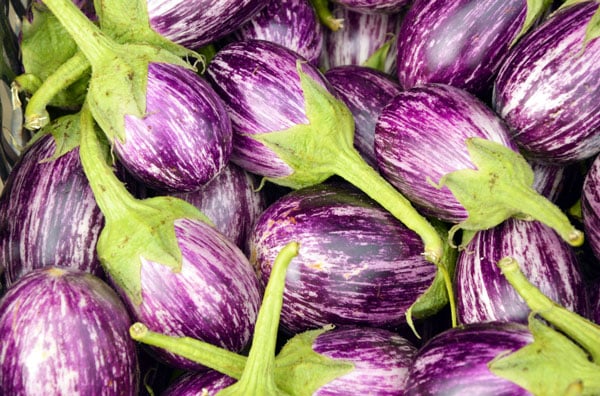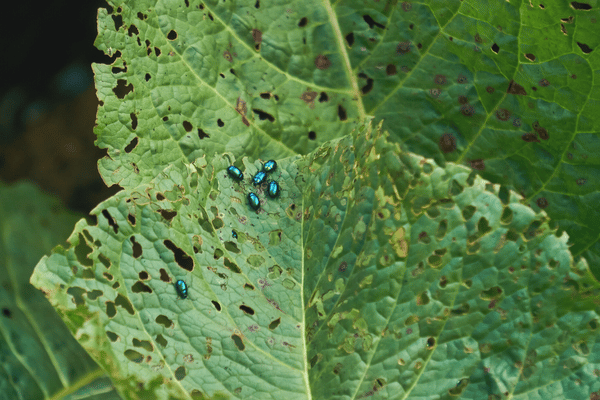This post may include affiliate links.
If you make a purchase, I'll earn a small fee at no extra cost to you.
You can grow amazing strawberries this year! These easy tips will show you: which kinds will give you the best harvest; the right sun, water, and soil for strawberries; and how to keep bugs away.
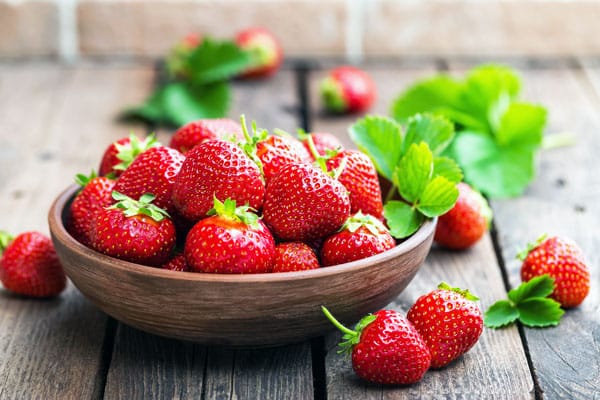
With two ravenous kids, strawberries are so popular around here that they’re practically considered a food group. We eat them right off the plant; we make strawberry freezer jam, strawberry popsicles, strawberry lemonade, strawberry fruit leather, strawberry shortcake…you get the picture.
From my years of experience growing and eating strawberries: here’s how to grow amazing strawberries in your garden, this year and every year.
~~~~~~~~~~~~
Are you a brand new gardener? Not sure what to plant and how to plant it? I can help.
Check out my Ultimate Beginning Gardener Bundle and you’ll have a great garden in no time!

~~~~~~~~~~~~
Strawberry Varieties
There are three main varieties of strawberries: everbearing, June-bearing, and alpine.
Everbearing strawberries (also called day-neutral) produce from spring through fall. My favorite everbearing variety is the delicious Albion strawberry.
June-bearing strawberries (sometimes called short-day) produce a large crop in spring. Plant these if you’re growing strawberries for a specific recipe, like strawberry freezer jam because they’ll all come ripe at once. Galletta strawberries are a perfect choice.
Alpine strawberries fruit all summer long, and can be white or cream colored, like the Alpine Yellow Wonder strawberry. Most have a more tropical flavor than the traditional strawberry–some folks love this and some think it’s weird, so be prepared!
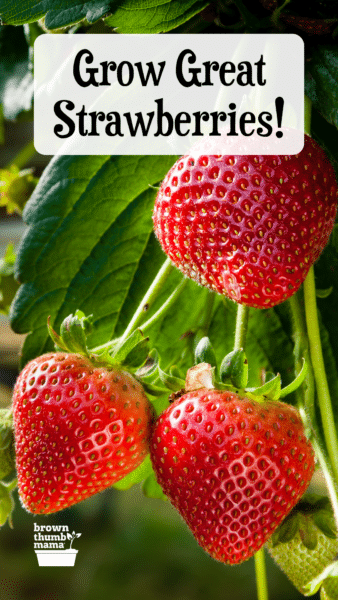
Sun, Water, Soil for Growing Strawberries
Choose a sunny area for your strawberries, because they need at least 6 hours of full sun per day. We planted ours in a corner of the yard near the path to the front door. Every time the kids walk by, they can grab a strawberry to munch on.
Strawberry plants need lots of water, but the berries can spoil if they sit on the wet ground. Drip lines or soaker hoses are great, as is watering first thing in the morning. Keep an eye on the soil so the roots don’t get soggy. If you’re growing berries in pots, check daily to make sure the soil hasn’t dried out.

I confess that I laughed when my dad bought me a box of these strawberry support gizmos…but now I’m completely sold. They keep the berries off the ground, make it easier to weed, and they help keep the snails and slugs away.
You put the two pieces together around the plant, so you can use them even if you’ve already planted. As you can see, each plant will produce multiple strawberries–so you’re well on your way to growing gallons of strawberries just with a few plants.
Like most veggies and fruits, strawberries appreciate a bit of fertilizer for added nutrients during the growing season. Add some homemade compost to the soil when planting and apply organic fertilizer about a month after planting.
If you have heavy clay soil that doesn’t drain well, it will be easier to grow amazing strawberries in a planter or strawberry pot. Use a couple bags of my favorite organic potting soil and you’ll be ready to go.
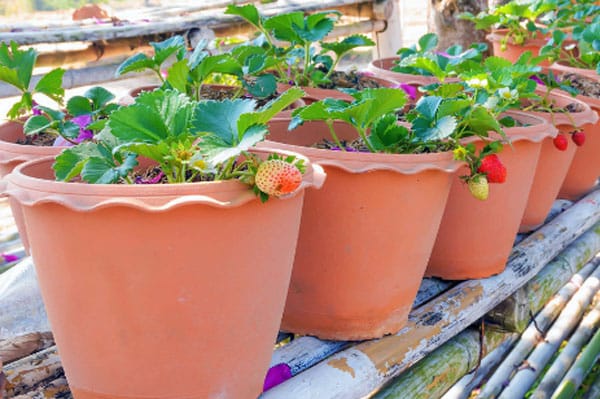
Planting & Spacing Strawberries
Some types of strawberries can be grown from seed but if you have eager strawberry eaters, transplants from the nursery are a better choice. If you start from seed, you won’t have strawberries until next year. <sad trombone>
There are three ways to plant strawberries—in rows, hills, and containers. Plant your strawberry starts in fall and/or in early spring.
To plant, start by digging shallow holes about 12-18 inches apart. Each seedling will have a thick central stem, called the crown. It’s important to keep the green part of crown above the surface of the soil when planting, just as it is here.
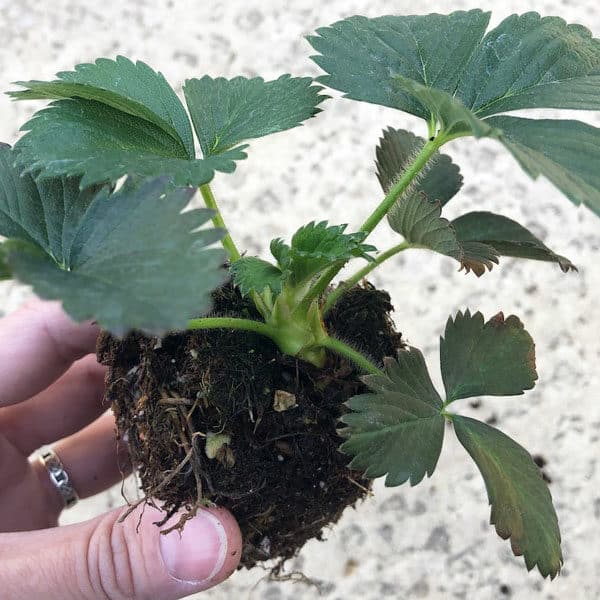
If you bury the green part of the crown, the plant will eventually rot and die. If the brown part of the crown is exposed, the plant will dry out, and…you guessed it.
If you’re growing in rows or hills, you’ll need to do a bit of maintenance. If the plants are too crowded they won’t produce good fruit—so as you’re munching your way through the strawberry patch, remove any dead leaves and berries you see.
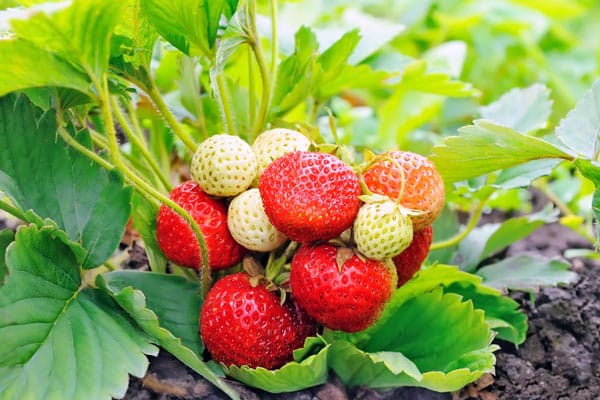
Strawberries grow well in containers, since their roots are fairly shallow. Remember that container plants need to be watered and fertilized more often than plants grown in the ground. Be sure your container has drainage holes so the roots don’t rot.
Lots of folks recommend using mulch or straw around your strawberry plants. Mulch is great in the garden, because it helps prevent weeds and keep moisture in the soil. However, I’ve found that natural mulch ends up being a hiding place for earwigs, snails, and slugs.
Professional strawberry farms use plastic sheeting on the soil, but I’d rather not use plastic in my home garden. I make up for the lack of mulch by monitoring the moisture levels in the soil.
As the strawberries get established they’ll send out runners, or stolons. Runners (strawberry “babies”) are a long stem that leads from the main strawberry plant (the “mother”) to a new area of the garden. A new strawberry plant will develop at the end of the runner, and once it gets established the stem linking the two plants will die.
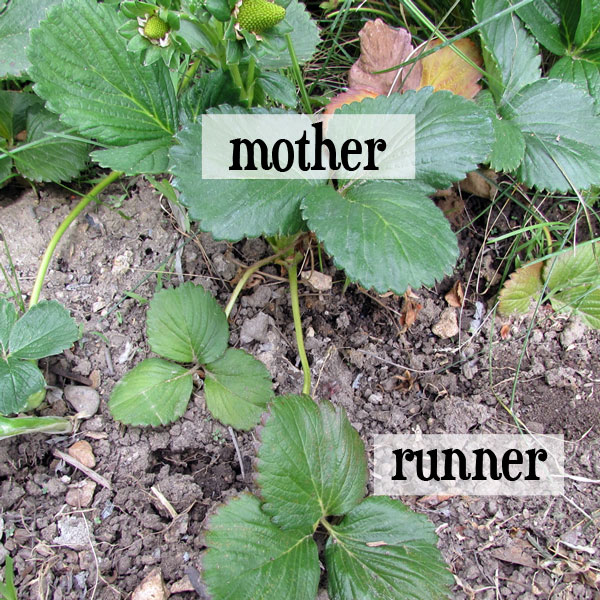
Hold on a minute now…I know what you’re thinking: “Hot diggity, I’ll just let the plants go crazy and send out a million runners. We’ll be overrun with strawberries in no time!”
It sounds like a good idea but those babies runners will weaken the main plant. (Moms, you know what I’m talking about.) For the first year, pinch off any runners and remove them. Just keep the main plant.
Pests, Diseases, & Companion Plants
Kids are not the only ones that like strawberries. Snails, slugs, and earwigs are big fans as well. You’ll know you have snails and slugs when you find holes in the berries. Here are the best natural ways to get rid of earwigs, and eliminate snails and slugs from your garden.
A great way to keep critters away from your strawberries is to plant them in hanging baskets. The snails and slugs will stay away, but there is a chance that birds will find your berries. If that’s the case, consider protecting your harvest with bird netting.
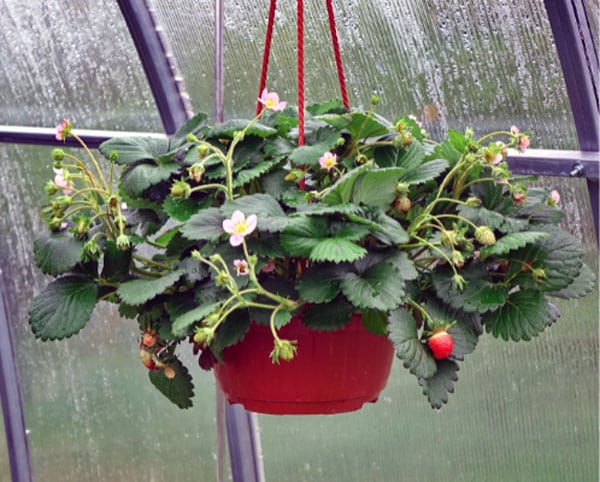
Don’t plant strawberries where you’ve previously grown tomatoes, peppers, eggplant, or potatoes. These plants can carry verticillium wilt (a soil-borne fungi) that will damage your plants. For this reason, don’t try to grow your strawberry patch by using runners from a friend’s garden. It’s best to buy healthy starts from a reputable nursery.
Did you know that (just like people) some plants work better together than others? This is known as companion planting, and it’s an important skill for all veggie gardeners.
Strawberries grow well with chives, bush beans, spinach, and/or borage. Plant your brassicas (broccoli, cauliflower, cabbage, etc) in another part of the garden—strawberries will hinder their growth.
Learn lots more about companion planting with the great book, Plant Partners: Science-Based Companion Planting Strategies for the Vegetable Garden.
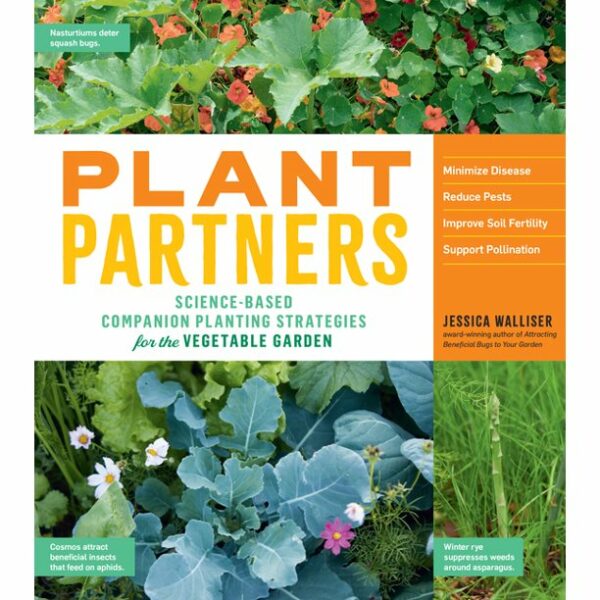
Harvesting Strawberries
Once your strawberries start ripening, you should pick them every couple of days. Only pick strawberries that are completely red all the way to the calyx (the green part). This little beauty needs one more day to ripen.

For storage, it’s best to cut the stem instead of pulling it off the plant. However, if you’re eating them immediately, like the kids do, the pull-and-munch technique is fine.
When picking, place them gently in a bowl to prevent bruising and spoiling. Store in the refrigerator for a day or two before eating or preserving. Yum!
My Favorite Strawberry Recipes
